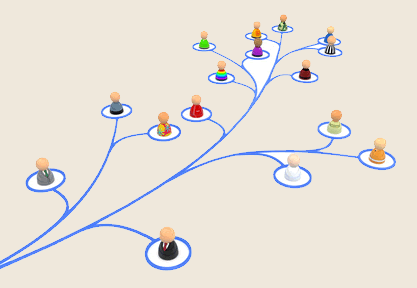Meaning of Grapevine Communication
Grapevine is an informal communication network, which ignores formal channels of communication and spreads rumors and gossips at all levels of the business organization. Although every business-organization has its formal channels of communication, the informal channel of communication called grapevine also operates in it. It can be easily found that a large portion of the communication in almost every business house is not formal or pre-planned. The employees communicate through informal channels as they do their jobs. It is neither pre-planned nor deliberately motivated by the management. It is neither written nor documented or recorded. Therefore, it refers to any communication that takes place outside the prescribed and pre-planned channels of formal business communication. It is not set with the lines of organizational hierarchy. As it has no set rules and regulations, it is not confined to a particular direction. It just spreads like a grapevine.
According to Prof. Keith Davis,
“Grapevine arises from social interaction, It is as fickle, dynamic and varied as people are. It is the exercise of their freedom of speech and is a natural, normal activity”.
The characteristics of grapevine communication include:
- Flexibility: There is no formal control over grapevine, so it is more flexible than other forms of communication.
- Rapid: It is faster than any form of communication.
- No record: There is no evidence which can be documented for future reference.
- Distortion: The message which is passed gets distorted when it passes from one person to another.
- Spontaneous: Grapevine communication is spontaneous as it is passed automatically from the top level of the organization to the bottom level without any difficulty in delivering the message.
Important Types of Grapevine Communication
The grapevine is the most sensitive and sensational channel of business communication. It is made of complex network of informal contacts among workers at all levels in an organization. Different types of grapevine communication are as follows:
- The Wheel: In this type of grapevine communication, one person is predominant. He transmits grapevine to different persons or group of persons. He is at the center and various lines of communication become the stokers of the wheel. Every person in the wheel becomes the causative factor for starting another wheel.
- The Cluster: The cluster like grapes, have several groups of people linked together by a cluster or chain of communication.
- The Chain: Chain is the most common pattern in which information passes through a series of people linked together in the organization.
- Free Flow: Most of the rumors or idle gossip is spread by random, free flow or haphazard network, which includes a number of people who are not necessarily linked by any organizational thread.
Importance of Grapevine Communication in Business
Though the structure of the grapevine communication is not so well defined, as that of the formal channels, it should not be taken for its weakness. The messages flowing through grapevine have greater speed than that of the messages flowing through the formal channels. The grapevine may carry equally vital message through it for the achievement and success of the organization. It is not correct to underestimate the grapevine communication by saying that the vital messages pass only through the authorized, formal channels. On the other hand, though the formal channels are systematic, pre-planned and documented, it is authority-laden. It can never be as speedy and spontaneous as the grapevine. The employees communicate through grapevine, not because they are compelled to communicate but because they earnestly want to communicate with their associates.
The method of formal written communication is slow and expensive method of information transmission. The grapevine, on the other hand, is non-expensive method and most-rapid oral method of transmitting the information to the maximum number of the communication receivers. The grapevine communication can flow wherever the participants wish it to flow, therefore, the manager can use the properly cultivated grapevine in dealing with the problems that require crossing the boundaries between the departments.
Grapevine communication originates from the psychological need of the employees to talk about their jobs and their associates as the subject of their main interest. The absence of grapevine communication surely creates the dull, sick and unfriendly atmosphere in the business organization. Grapevine communication is also described as the barometer of public opinion in the organization. If the manager is sensitive to it, he can gather information about the ideas, opinions, attitudes and interests of the employees.
The grapevine communication gives an opportunity to the employees to let off the suppressed air of anxiety, worries and frustration. When they talk about their associates, they get emotional relief. The fact that the employees talk about their associates or that they have the interest in their associates is a proof of the high morale. Thus, the grapevine communication not only promotes unity, integrity and solidarity of the organization but it also helps to raise the morale of the employees.
Limitations of Grapevine Communication
- The grapevine communication may carry some degree of error in it.
- The baseless, imaginary and non-factual messages may prove harmful to the organization.
- Often the employees feed the grapevine with self-serving information. They add to the facts rather than simply report.
- The grapevine often carries incomplete information, which leads to misunderstanding of the receiver.
- The communicator does not take the responsibility of the message.
- Sometimes the grapevine spreads the message so swiftly that it causes damage to the organization.

Exactly what I needed, thanks a lot.